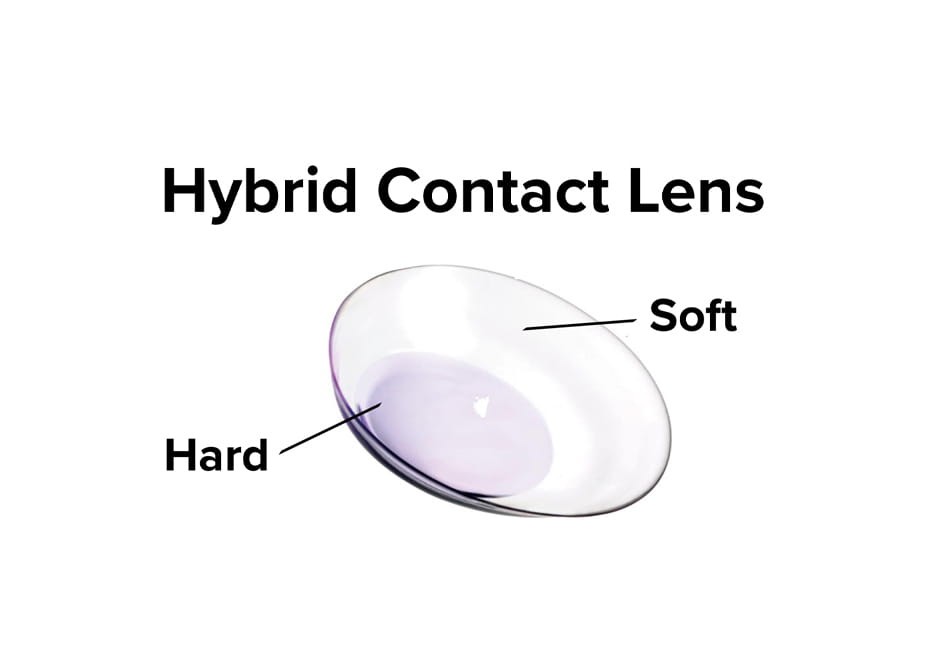Hybrid lenses are the game-changing solution for individuals living with keratoconus. These innovative contact lenses combine the best features of both rigid gas permeable (RGP) and soft contact lenses, providing unparalleled vision correction and comfort.
At the Khanna Vision Institute, we’ve seen firsthand how hybrid lenses can transform the lives of our keratoconus patients. Unlike traditional RGP lenses, which can be uncomfortable and difficult to adapt to, hybrid lenses offer a seamless blend of the crisp optics of RGP materials and the soothing cushion of soft lens designs.
The unique construction of hybrid lenses allows them to vault over the irregular cornea, providing clear, distortion-free vision. Additionally, the soft outer ring conforms to the eye’s shape, minimizing irritation and improving overall comfort. Patients who have struggled with traditional contact lens options often find that hybrid lenses are the perfect solution for managing their keratoconus.

Hybrid Lenses
Purpose: Hybrid lenses aim to provide the clear vision associated with RGP lenses while ensuring the comfort of soft lenses. They are particularly useful for patients with irregular corneas, such as those caused by keratoconus.
Structure:
RGP Center: The central part of a hybrid lens is made from a rigid gas permeable material. This hard center provides a smooth refractive surface that corrects the distorted vision caused by the irregular cornea.
Soft Skirt: Surrounding the RGP center is a soft lens skirt. This part of the lens rests on the sclera (the white part of the eye) and provides the comfort and stability of a soft lens.
How it works:
Vision Correction: The RGP center of the hybrid lens masks the irregular shape of the cornea, providing clearer and more stable vision compared to soft lenses alone.
Comfort and Fit: The soft skirt enhances comfort, reduces the likelihood of lens dislocation, and ensures the lens fits snugly on the eye, minimizing discomfort often associated with RGP lenses.
Advantages:
Enhanced Comfort: The soft skirt of the hybrid lens improves comfort, making it more tolerable for patients who cannot wear RGP lenses due to discomfort.
Better Visual Acuity: The rigid center provides superior vision correction by masking corneal irregularities, offering clearer vision than soft lenses.
Stability: The soft skirt helps keep the lens centered on the eye, reducing movement and maintaining consistent vision.
Limitations:
Complex Fitting Process: Hybrid lenses require precise fitting by an eye care professional experienced in dealing with keratoconus. Multiple visits may be necessary to achieve the optimal fit.
Care and Maintenance: Hybrid lenses require careful handling and specific cleaning solutions to maintain their condition and prevent eye infections.
Cost: These lenses can be more expensive than standard soft or RGP lenses due to their specialized design and materials.
Usage and Care:
Fitting: An eye care professional will conduct a thorough fitting process, which may involve taking detailed measurements of the cornea and sclera to ensure the lens fits correctly.
Wearing Schedule: Initially, the wearer may need to gradually increase the wear time to allow the eyes to adapt to the new lenses.
Cleaning: Hybrid lenses require daily cleaning with specific solutions recommended by the eye care provider to maintain lens hygiene and ocular health.
If you or a loved one are living with keratoconus, we encourage you to explore the transformative benefits of hybrid lenses. At the Khanna Vision Institute, our team of experienced eye care professionals is dedicated to helping you achieve the best possible vision and quality of life. Take the first step towards clearer, more comfortable sight by scheduling a consultation today.